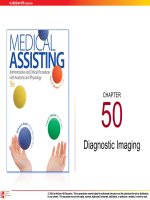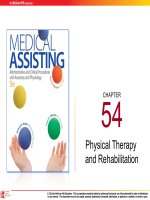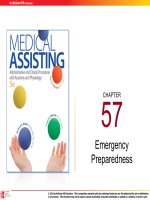Medical assisting Administrative and clinical procedures (5e) Chapter 50 Diagnostic imaging
Bạn đang xem bản rút gọn của tài liệu. Xem và tải ngay bản đầy đủ của tài liệu tại đây (1.12 MB, 52 trang )
CHAPTER
50
Diagnostic Imaging
© 2014 by McGraw-Hill Education. This is proprietary material solely for authorized instructor use. Not authorized for sale or distribution
in any manner. This document may not be copied, scanned, duplicated, forwarded, distributed, or posted on a website, in whole or part.
50-2
Learning Outcomes
50.1 Explain what X-rays are and how they are
used for diagnostic and therapeutic
purposes.
50.2 Compare invasive and noninvasive
diagnostic procedures.
50.3 Carry out the medical assistant’s role in
X-ray and diagnostic radiology testing.
50.4 Discuss common diagnostic imaging
procedures.
© 2014 by McGraw-Hill Education. This is proprietary material solely for authorized instructor use. Not authorized for sale or distribution
in any manner. This document may not be copied, scanned, duplicated, forwarded, distributed, or posted on a website, in whole or part.
50-3
Learning Outcomes
50.5 Describe different types of radiation therapy
and how they are used.
50.6 Explain the risks and safety precautions
associated with radiology work.
50.7 Relate the advances in medical imaging to
EHR.
© 2014 by McGraw-Hill Education. This is proprietary material solely for authorized instructor use. Not authorized for sale or distribution
in any manner. This document may not be copied, scanned, duplicated, forwarded, distributed, or posted on a website, in whole or part.
50-4
Introduction
• Diagnostic
radiology
• Medical assistant
– Role during testing
– Screening
– Safety issues
– Clinical diagnosis
– Proper handling
and storage of films
– Preparation and
instruction of
patients
© 2014 by McGraw-Hill Education. This is proprietary material solely for authorized instructor use. Not authorized for sale or distribution
in any manner. This document may not be copied, scanned, duplicated, forwarded, distributed, or posted on a website, in whole or part.
50-5
Brief History of the X-Ray
• Discovered in 1895
by Wilhelm
Konrad Roentgen
• X-ray
– High energy level
– Short wavelength
© 2014 by McGraw-Hill Education. This is proprietary material solely for authorized instructor use. Not authorized for sale or distribution
in any manner. This document may not be copied, scanned, duplicated, forwarded, distributed, or posted on a website, in whole or part.
50-6
Brief History of the X-Ray (cont.)
• Diagnostic and therapeutic uses
• Radiologic technologists
• Radiologist
– Performs invasive
procedures
– Interprets films
© 2014 by McGraw-Hill Education. This is proprietary material solely for authorized instructor use. Not authorized for sale or distribution
in any manner. This document may not be copied, scanned, duplicated, forwarded, distributed, or posted on a website, in whole or part.
50-7
Diagnostic Radiology
• Use of X-ray technology to diagnose
• Contrast medium
– Makes internal organs denser
– Produces a clearer image
– Types
• Gases
• Heavy metal salts
• Paramagnetic compounds
• Iodine compounds
© 2014 by McGraw-Hill Education. This is proprietary material solely for authorized instructor use. Not authorized for sale or distribution
in any manner. This document may not be copied, scanned, duplicated, forwarded, distributed, or posted on a website, in whole or part.
50-8
Diagnostic Radiology (cont.)
• Invasive procedures
– A testing device is inserted
into a blood vessel or organ
– Requires surgical aseptic
technique
– Patients must be closely
monitored
© 2014 by McGraw-Hill Education. This is proprietary material solely for authorized instructor use. Not authorized for sale or distribution
in any manner. This document may not be copied, scanned, duplicated, forwarded, distributed, or posted on a website, in whole or part.
50-9
Diagnostic Radiology (cont.)
• Noninvasive procedures
– View internal structures
– Uses the conventional
x-ray machine or
specialized instruments
© 2014 by McGraw-Hill Education. This is proprietary material solely for authorized instructor use. Not authorized for sale or distribution
in any manner. This document may not be copied, scanned, duplicated, forwarded, distributed, or posted on a website, in whole or part.
50-10
Apply Your Knowledge
electromagnetic
1. X-rays are __________________
waves that travel at the
speed of light and penetrate solid objects
2. What is the difference in noninvasive and invasive
procedures?
ANSWER: Noninvasive procedures do not require
inserting devices, breaking the skin, or special
monitoring and use conventional x-ray machines or
specialized instruments to visualize internal organs.
Invasive procedures require surgical aseptic technique
for the insertion of a catheter, wire, or other testing
device into an organ or blood vessel.
© 2014 by McGraw-Hill Education. This is proprietary material solely for authorized instructor use. Not authorized for sale or distribution
in any manner. This document may not be copied, scanned, duplicated, forwarded, distributed, or posted on a website, in whole or part.
50-11
Medical Assistant’s Role in Diagnostic
Radiology
• Assist with or perform
procedures
– Based on scope of
practice for state
– Pre- and
postprocedure care
– Patient education
© 2014 by McGraw-Hill Education. This is proprietary material solely for authorized instructor use. Not authorized for sale or distribution
in any manner. This document may not be copied, scanned, duplicated, forwarded, distributed, or posted on a website, in whole or part.
50-12
Medical Assistant’s Role in Diagnostic
Radiology (cont.)
• Preprocedure care
– Schedule appointments
– Provide preparation instructions
– Explain the procedure
– Ask pertinent questions
• Medication history
• Women – possibility of pregnancy
© 2014 by McGraw-Hill Education. This is proprietary material solely for authorized instructor use. Not authorized for sale or distribution
in any manner. This document may not be copied, scanned, duplicated, forwarded, distributed, or posted on a website, in whole or part.
50-13
Medical Assistant’s Role in Diagnostic
Radiology (cont.)
• Care during and after a procedure
– Prepare and assist the patient
– Assist the radiologic technologist or radiologist
Posteroanterior
(back to front)
© 2014 by McGraw-Hill Education. This is proprietary material solely for authorized instructor use. Not authorized for sale or distribution
in any manner. This document may not be copied, scanned, duplicated, forwarded, distributed, or posted on a website, in whole or part.
50-14
Medical Assistant’s Role in Diagnostic
Radiology (cont.)
• Verifying insurance
– Prior to testing
– Obtain necessary referrals
– Be sure to schedule at a facility
contracted with the patient’s
health insurance
© 2014 by McGraw-Hill Education. This is proprietary material solely for authorized instructor use. Not authorized for sale or distribution
in any manner. This document may not be copied, scanned, duplicated, forwarded, distributed, or posted on a website, in whole or part.
50-15
Apply Your Knowledge
How can you find out what role you can take in
radiologic testing as a medical assistant?
ANSWER: Check your scope of practice for
the state you are working in.
© 2014 by McGraw-Hill Education. This is proprietary material solely for authorized instructor use. Not authorized for sale or distribution
in any manner. This document may not be copied, scanned, duplicated, forwarded, distributed, or posted on a website, in whole or part.
50-16
Common Diagnostic Radiologic Tests
• Common tests
• Contrast media in diagnostic tests
– Administered orally, IV, by enema
– Adverse effects
• Mild to severe
• Localized to systemic
• Check for allergy to iodine or shellfish
– Monitor patient for signs of allergy
© 2014 by McGraw-Hill Education. This is proprietary material solely for authorized instructor use. Not authorized for sale or distribution
in any manner. This document may not be copied, scanned, duplicated, forwarded, distributed, or posted on a website, in whole or part.
50-17
Common Diagnostic Radiologic
Tests (cont.)
• Fluoroscopy
– X-rays cause certain chemicals to emit visible
light
– Allows for viewing movement of an organ or a
contrast medium through organs
© 2014 by McGraw-Hill Education. This is proprietary material solely for authorized instructor use. Not authorized for sale or distribution
in any manner. This document may not be copied, scanned, duplicated, forwarded, distributed, or posted on a website, in whole or part.
50-18
Common Diagnostic Radiologic
Tests (cont.)
• Hysterosalpingography
– Examination of uterus and fallopian tubes by
fluoroscopy
– Used to evaluate shape and structure of
uterus and patency
of fallopian tubes
© 2014 by McGraw-Hill Education. This is proprietary material solely for authorized instructor use. Not authorized for sale or distribution
in any manner. This document may not be copied, scanned, duplicated, forwarded, distributed, or posted on a website, in whole or part.
50-19
Common Diagnostic Radiologic
Tests (cont.)
• Angiography
– Invasive procedure using a
contrast medium
– Assess arteries or veins
– Medical assistant
• Schedule
• Answer questions
© 2014 by McGraw-Hill Education. This is proprietary material solely for authorized instructor use. Not authorized for sale or distribution
in any manner. This document may not be copied, scanned, duplicated, forwarded, distributed, or posted on a website, in whole or part.
50-20
Common Diagnostic Radiologic
Tests (cont.)
• Arthrography
– Contrast medium and fluoroscopy
– Provides an image during movement
– Used to diagnose abnormalities or injuries in
cartilage, tendons, or ligaments
© 2014 by McGraw-Hill Education. This is proprietary material solely for authorized instructor use. Not authorized for sale or distribution
in any manner. This document may not be copied, scanned, duplicated, forwarded, distributed, or posted on a website, in whole or part.
50-21
Common Diagnostic Radiologic
Tests (cont.)
• Barium enema
– Contrast media
• Single-contrast – barium
• Double-contrast – barium and air
– Diagnose and evaluate the colon or rectum.
– Patient instructions and compliance important
© 2014 by McGraw-Hill Education. This is proprietary material solely for authorized instructor use. Not authorized for sale or distribution
in any manner. This document may not be copied, scanned, duplicated, forwarded, distributed, or posted on a website, in whole or part.
50-22
Common Diagnostic Radiologic
Tests (cont.)
• Barium swallow
– Contrast medium – barium
– Diagnose and evaluate the esophagus,
stomach, duodenum, and small intestine
– Patient instructions and compliance important
© 2014 by McGraw-Hill Education. This is proprietary material solely for authorized instructor use. Not authorized for sale or distribution
in any manner. This document may not be copied, scanned, duplicated, forwarded, distributed, or posted on a website, in whole or part.
50-23
Common Diagnostic Radiologic
Tests (cont.)
• Cholecystography
– Oral contrast
medium
– Detect gallstones
or abnormalities of
the gallbladder
• Cholangiography
– Contrast medium
injected into
common bile duct
– Evaluate function
of bile duct
© 2014 by McGraw-Hill Education. This is proprietary material solely for authorized instructor use. Not authorized for sale or distribution
in any manner. This document may not be copied, scanned, duplicated, forwarded, distributed, or posted on a website, in whole or part.
50-24
Common Diagnostic Radiologic
Tests (cont.)
• Conventional tomography
– Uses a computerized camera that moves
back and forth over the patient
– One view per arc over patient
• Computer tomography
– Camera rotates completely around the patient
– Cross-sectional view from each rotation
© 2014 by McGraw-Hill Education. This is proprietary material solely for authorized instructor use. Not authorized for sale or distribution
in any manner. This document may not be copied, scanned, duplicated, forwarded, distributed, or posted on a website, in whole or part.
50-25
Common Diagnostic Radiologic
Tests (cont.)
• Heart X-ray
– Angiocardiography
• Contrast medium used
• Images of medium flowing through the
heart, lungs, and major vessels
– Coronary arteriography
© 2014 by McGraw-Hill Education. This is proprietary material solely for authorized instructor use. Not authorized for sale or distribution
in any manner. This document may not be copied, scanned, duplicated, forwarded, distributed, or posted on a website, in whole or part.









